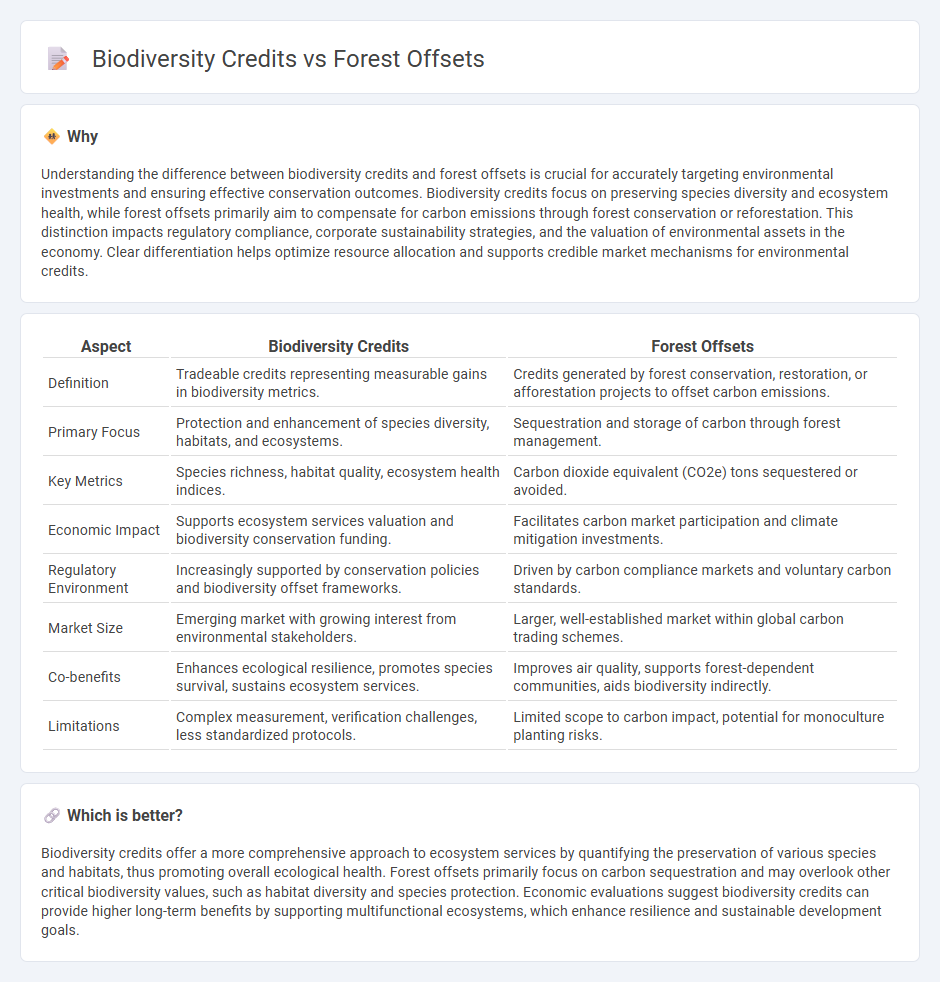
Biodiversity credits and forest offsets represent innovative economic tools designed to mitigate environmental impact by assigning monetary value to ecosystem services. Biodiversity credits specifically target the preservation and restoration of diverse biological species and habitats, while forest offsets focus on compensating for carbon emissions through forest conservation and reforestation. Explore the distinctions and benefits of these market-based mechanisms to understand their roles in sustainable development.
Why it is important
Understanding the difference between biodiversity credits and forest offsets is crucial for accurately targeting environmental investments and ensuring effective conservation outcomes. Biodiversity credits focus on preserving species diversity and ecosystem health, while forest offsets primarily aim to compensate for carbon emissions through forest conservation or reforestation. This distinction impacts regulatory compliance, corporate sustainability strategies, and the valuation of environmental assets in the economy. Clear differentiation helps optimize resource allocation and supports credible market mechanisms for environmental credits.
Comparison Table
| Aspect | Biodiversity Credits | Forest Offsets |
|---|---|---|
| Definition | Tradeable credits representing measurable gains in biodiversity metrics. | Credits generated by forest conservation, restoration, or afforestation projects to offset carbon emissions. |
| Primary Focus | Protection and enhancement of species diversity, habitats, and ecosystems. | Sequestration and storage of carbon through forest management. |
| Key Metrics | Species richness, habitat quality, ecosystem health indices. | Carbon dioxide equivalent (CO2e) tons sequestered or avoided. |
| Economic Impact | Supports ecosystem services valuation and biodiversity conservation funding. | Facilitates carbon market participation and climate mitigation investments. |
| Regulatory Environment | Increasingly supported by conservation policies and biodiversity offset frameworks. | Driven by carbon compliance markets and voluntary carbon standards. |
| Market Size | Emerging market with growing interest from environmental stakeholders. | Larger, well-established market within global carbon trading schemes. |
| Co-benefits | Enhances ecological resilience, promotes species survival, sustains ecosystem services. | Improves air quality, supports forest-dependent communities, aids biodiversity indirectly. |
| Limitations | Complex measurement, verification challenges, less standardized protocols. | Limited scope to carbon impact, potential for monoculture planting risks. |
Which is better?
Biodiversity credits offer a more comprehensive approach to ecosystem services by quantifying the preservation of various species and habitats, thus promoting overall ecological health. Forest offsets primarily focus on carbon sequestration and may overlook other critical biodiversity values, such as habitat diversity and species protection. Economic evaluations suggest biodiversity credits can provide higher long-term benefits by supporting multifunctional ecosystems, which enhance resilience and sustainable development goals.
Connection
Biodiversity credits and forest offsets are interconnected mechanisms that enable businesses to compensate for environmental impacts by funding conservation projects. Forest offsets specifically focus on preserving or restoring tree-rich ecosystems, which directly contribute to biodiversity conservation by maintaining habitats and species diversity. Both tools support sustainable development goals by promoting carbon sequestration and protecting natural ecosystems critical for biodiversity.
Key Terms
Carbon Sequestration
Forest offsets primarily focus on carbon sequestration by promoting reforestation and improved forest management to capture atmospheric CO2, playing a crucial role in mitigating climate change. Biodiversity credits, while also supporting carbon storage, emphasize preserving ecosystem health and species diversity, delivering broader environmental benefits beyond carbon reduction. Explore the distinctions and synergies between these mechanisms to enhance your understanding of sustainable environmental finance.
Ecosystem Services
Forest offsets primarily target carbon sequestration by preserving or restoring forested areas to mitigate greenhouse gas emissions, while biodiversity credits focus on protecting and enhancing species diversity and ecosystem resilience. Both contribute to ecosystem services by supporting water purification, soil stabilization, and habitat provision, yet biodiversity credits emphasize biological variety beyond carbon metrics. Explore deeper insights into how these mechanisms complement each other in sustaining ecosystem health and climate goals.
Additionality
Forest offsets represent carbon sequestration projects that compensate for greenhouse gas emissions by preserving or enhancing forest carbon stocks, with strict additionality criteria ensuring emissions reductions would not occur without the offset project. Biodiversity credits primarily target the conservation or restoration of species habitats, focusing on measurable improvements in biodiversity metrics beyond existing baselines, also requiring clear additionality to avoid crediting ongoing or business-as-usual conservation. Explore the nuances of additionality in both mechanisms to understand their distinct impacts on climate and ecological goals.
Source and External Links
Introduction to Forest Carbon, Offsets and Markets - Forest carbon offsets are generated through three main project types: afforestation/reforestation, avoided conversion of forestland, and improved forest management, each with distinct rules and methodologies for carbon sequestration and verification.
Forestry and Afforestation | RGGI, Inc. - US forest carbon offsets increase carbon stocks via reforestation, improved forest management, or avoided conversion, with credits awarded based on measured net carbon sequestration during reporting periods.
Forest Carbon Offsets: Everything You Need To Know - Challenges in forest offsets include proving additionality (ensuring the project causes extra carbon reduction) and permanence, as risks like wildfire can reverse carbon storage, threatening the long-term validity of offset credits.
 dowidth.com
dowidth.com